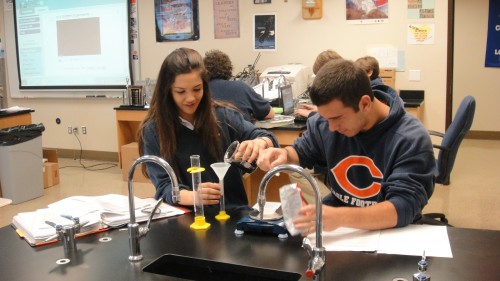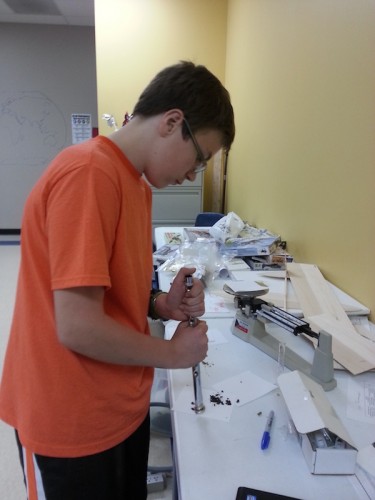As a testament to the capabilities of SSEP to both inspire, and to immerse students in a real research experience, we wanted to showcase two SSEP research teams. First, Michal Bodzianowski, the Principal Investigator (PI) in Highlands Ranch, Colorado, whose Mission 4 experiment just returned to Earth yesterday on Soyuz 36S. Second, a Mission 1 to ISS research team: Co-PIs Max Holden and Paige D’ Andrea, whose experiment was the inspiration for Michal’s experiment. Isn’t that how science really works?
Michal proposed an experiment to assess fermentation of beer in space, and the media coverage that ensued was not just national but international. We’ve highlighted many of the articles below. You’ll note that in the TIME/CNN video below, Michal says that SSEP has resulted in “my greatest moment in my life so far”. We can imagine no greater testimonial to the power of this program than the impact Michal says SSEP has made on his life. In the HuffPost Live video below, Michal noted that he came up with the idea when he saw a writeup of Max’s and Paige’s Mission 1 flight experiment on fermentation of wine in space. We can imagine no greater testimonial to authentic research experiences for students than when a prior body of work is called upon to further research.
Below are the details of both flight experiments, and a video of Max Holden reporting results from the Mission 1 experiment at the 2013 SSEP National Conference at the Smithsonian National Air and Space Museum, in Washington, DC, July 2013.
More generally, you are invited to explore the SSEP “In the News” pages for Mission 1 to ISS and Mission 4 to ISS, as well as the extensive NASA and CASIS coverage of SSEP (CASIS is a National Partner on SSEP).
HIGHLAND RANCH, CO, MISSION 4 EXPERIMENT SELECTED FOR FLIGHT
What Are the Effects of Creation of Beer in Microgravity and is it Possible?
Grade 6, STEM School and Academy, Douglas County School District
Principal Investigator: Michal Bodzianowski
Teacher Facilitator: Sharon Combs, Physical Science Teacher
Proposal Summary:
By combining the four main ingredients (malt barley, hops, yeast, and water) of beer in space, will we be able to produce alcohol? This question was inspired by the use of beer as a replacement to regular water, as the alcohol killed bacteria that were in regular water. If an emergency occurred, and all water was polluted, creating beer from it will disinfect it, and it is relatively cheaper than purifying it with special tablets that may not last. And as it kills bacteria, it can also be used medically to disinfect wounds. The experiment’s results will be useful for both medical and survival reasons, and it is fairly easy to conduct with limited human interactions. Experiment will be measured by hydrometer tests to see if any alcohol was produced by the yeast-sugar reaction.
WEST HILLS, CA, MISSION 1 EXPERIMENT SELECTED FOR FLIGHT
Microgravity Wine
Grades 9 and 10; Chaminade College Preparatory
Co-Principal Investigators: Max Holden and Paige D’ Andrea
Teacher Facilitators: Eric Esby and Nancy McIntyre
 Proposal Summary:
Proposal Summary:
Our experiment will be testing the speed of fermentation when it is exposed to microgravity. When something is in microgravity it is in a constant free fall, so it will constantly be moving the solution of grape juice and yeast. When the sugar in the grape juice is mixed with the yeast it will begin to ferment due to lack of oxygen when it ferments it will produce ethyl alcohol and Carbon Dioxide. The microgravity will constantly be moving the cells in the solution, which we think will either speed up of slow down the process of fermentation. We will be testing the fermentation by using a titration rating, which will measure the amount of dissolved Carbon dioxide in the solution. By finding the titration rating we will be able to see if the one in an environment with gravity or the one in an environment without gravity produced more Carbon Dioxide. Whichever solution gave off more Carbon Dioxide is the one that fermented faster than the other.
PI Max Holden Presenting at 2013 SSEP National Conference
Sample of Media Coverage for PI Michal Bodzianowski’s Mission 4 Experiment
VIDEO: 11-Year-Old to Brew Beer in Space
TIME / CNN, October 2013
http://content.time.com/time/video/player/0,32068,2728828234001_2154193,00.html
‘Space Oddity’ David Bowie’s Way, and Newer Takes
New York Times, October 22, 2013
http://www.nytimes.com/2013/10/22/booming/space-oddity-david-bowies-way-and-newer-takes.html?_r=0
11-year-old’s beer brewery to be sent to space station
NBCNEWS, October 11, 2013
http://www.nbcnews.com/science/space/11-year-olds-beer-brewery-be-sent-space-station-f8C11375439
VIDEO: Beer In Space: 11-Year-Old’s Tiny Brewery Will Fly to Space Station
SPACE.COM, October 10, 2013
http://www.space.com/23141-space-beer-student-space-station-experiment.html
Michal Bodzianowski, 11-Year-Old Colorado Boy, Will Brew Beer In Space
International Business Times, October 8, 2013
http://www.ibtimes.com/michal-bodzianowski-11-year-old-colorado-boy-will-brew-beer-space-photo-1416866
VIDEO: Kid Wins Approval To Test Microbrewing In Space
HuffPost Live, October 8, 2013
http://live.huffingtonpost.com/r/segment/kid-wins-approval-to-test-microbrewing-in-space/52545e30fe34441574000110
Sixth Grader Wins Approval to Brew Beer in Space
ABC News, October 7, 2013
http://abcnews.go.com/blogs/headlines/2013/10/sixth-grader-wins-approval-to-brew-beer-in-space/
One small stout for man: Student, 11, develops way to brew BEER in space
Daily Mail, UK, October 7, 2013
http://www.dailymail.co.uk/news/article-2449203/Michal-Bodzianowski-wins-competition-One-small-stout-man-Student-11-develops-way-brew-BEER-space.html
VIDEO: Daniel’s List: 22 Acts of Kindness
Katie Couric, October 2013
http://katiecouric.com/videos/daniels-list-22-acts-of-kindness/
VIDEO: Science Project to Space (at timestamp 4:06)
Aljazeera America News, October 2013
https://ajam.app.box.com/s/xpkaleggbshs9t2qg2v1
The Student Spaceflight Experiments Program (SSEP) is a program of the National Center for Earth and Space Science Education (NCESSE) in the U.S., and the Arthur C. Clarke Institute for Space Education internationally. It is enabled through a strategic partnership with NanoRacks LLC, working with NASA under a Space Act Agreement as part of the utilization of the International Space Station as a National Laboratory. SSEP is the first pre-college STEM education program that is both a U.S. national initiative and implemented as an on-orbit commercial space venture.
The Smithsonian National Air and Space Museum, Center for the Advancement of Science in Space (CASIS), and Subaru of America, Inc., are National Partners on the Student Spaceflight Experiments Program.





